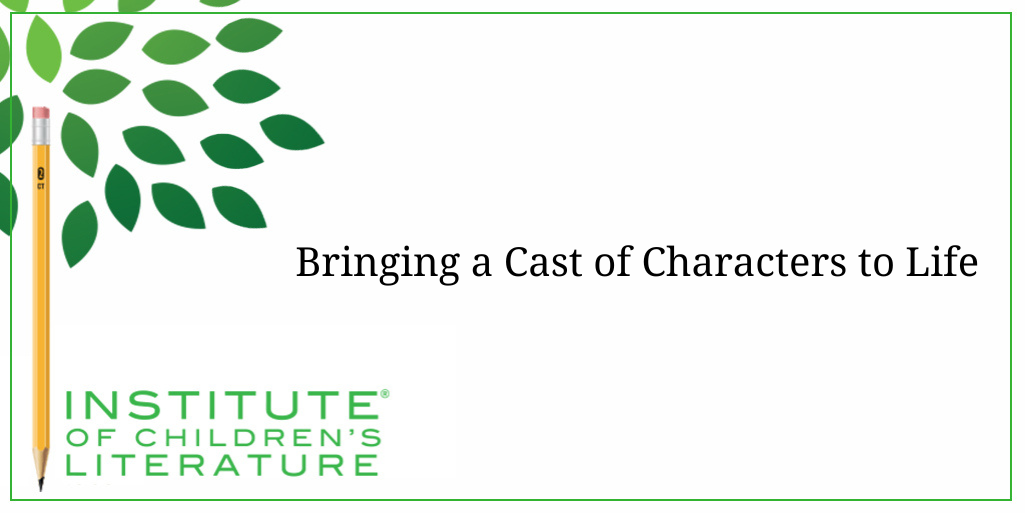
5 Ways Writers Can Prep for 2025 Goal Setting
Before we roll on to the new writing year, let’s harness our optimism for the blank slate before us and prepare for our 2025 Goal Setting just for writers.

Characters are the life that fill up your stories. Writing well-developed characters are as essential to the story as the plot, but they work in concert with the plot to bring forth a rich, meaningful story. Because of this, characters tend to fall into certain roles and it’s worthwhile to think about these roles and what is required of your cast of characters to fill each one.
The protagonist is the main character of your story. The protagonist may be a hero whose goals and actions are applauded by the reader. Or the protagonist may be an anti-hero whose actions and goals are less praiseworthy but still followed eagerly by the reader. In some cases, protagonists aren’t heroic at all and revel in their villain status throughout the story.
In any case, the protagonists drive the show through their actions, reactions and motivations. Despite how different these possible types of protagonists are, there are some things that are always true of this character. Let’s look at them.
First, and possibly most important, readers need to relate to your protagonist. This means there must be some connection the reader can make to care about what happens to this protagonist. A villain protagonist, for example, could be funny or charming, or the villain protagonist could be struggling in ways the reader can relate to.

Sometimes readers can relate to a character because they relate to the character’s situation. This is one reason why elderly characters can sometimes work in children’s books. Children relate to an elderly person’s lack of power or a tendency for others not to take the elderly person seriously. This is also why adult main characters in children’s books sometimes have characteristics we think of as childlike such as being impulsive or forgetful.
Main characters also must have believable motivations for their actions. For instance, if you send your characters into a terrifying haunted house, there must be a strong motivation pushing them in and keeping them in. Never let your reader wonder: why didn’t he just stop? Readers need to know why your character is doing what he’s doing and believe in it. These motivations also need to be special to that character, so be careful of making characters who are too much like all the other characters in that genre.
Let’s take an example from outside of books and kids and think about the modern police officer. If he’s the main character and male, he is almost certain to have had some sort of tragedy in his life that drives him and it’s probably his dead wife (though dead child is a close second). Because this kind of tragic device is so common, it’s come to lose much of its power for the viewer. And, we don’t want that.
Successful kidlit tends not to go for the easy, familiar set-up in order to motivate characters to do what you need them to do. But whatever story you tell, you must come up with reasons for your characters to act, and the reasons need to grow out of who these people are and what they have experienced. Motivation is going to be present in every character, but nowhere is it more important than in the protagonist.
The final sure thing in a protagonist is that the story will change them. In a series, the change in the main character may be subtle (since you don’t want to use up all the growth and change opportunities in one book), but they should be there. The character experiences a challenge in the story and responds to it, so something will change in the person.
Whatever change you choose, it must grow believably from what they experience.
 Consider a Sidekick
Consider a SidekickThe sidekick character has a number of possible benefits. The sidekick can give your main character someone to talk to and can ask the questions the readers wish they could ask. The sidekick can allow you to give the reader information in believable ways. The sidekick can add a note of comedy to the story. Or the sidekick can help make the story more touching or more inspiring. The sidekick can bring an alternate viewpoint to a situation, which can be helpful in letting the reader figure out what’s going on.
Though the sidekick is a useful tool, this character must be more than that. The sidekick still needs to read like a real person. The sidekick must have a personality and motivations that are different from the main character. The sidekick will need a unique voice. This will keep the sidekick from feeling flat or dull or too convenient.
Conversations with the sidekick, for instance, may serve the purpose of feeding information to the reader, but they must not sound like that is what they are doing. They need to sound like natural conversations that would be logically had at that moment and grow out of the personalities of the protagonist and sidekick characters. No tool is valuable in a story if it isn’t believable.
The antagonist in a story stands in the way of the main character achieving the story’s goals. The antagonist doesn’t have to be a bad guy. The antagonist can be a well-meaning parent, a concerned adult, a good friend—nothing about the antagonist needs to be negative. It’s the role of obstacle that defines this character, not the character’s morals or personality. As with protagonists and sidekicks, the behavior of an antagonist must have clear, believable motivations and the antagonist needs a personality and voice that is different from other characters.
Not all stories have a separate antagonist. Sometimes it isn’t a person who stands in the way of the main character achieving what the plot demands. Sometimes the main character’s challenge comes entirely from his own weaknesses or from the situation he is in.
For example, a story where a main character and his mom are driving in a snowstorm and have an accident might pit the main character against the elements to save his mom with no antagonist character at all. In a situation like that, the antagonist would be nature or “the storm.” A solid story needs something that stands in the way of the protagonist achieving the story goals; sometimes it’s a separate character (or more than one separate character), but sometimes a different story element will serve in that role.
 Team Efforts
Team EffortsSome stories work as team efforts where there is an ensemble cast that must work together to overcome the challenge. In my own MONSTER HUNTERS series, there is an ensemble cast working together, even though I have a single main character. Because I still have the main character, the ensemble acts a bit like having a main character and multiple sidekicks.
Sometimes books can have a cast of characters where the viewpoint jumps between characters without allowing any one character to dominate. In this case, the group truly works together to solve the problem. Ensemble casts can be hard to write as every character needs a strong motivation for every action, and every character needs a clear and distinct voice. This kind of complex character creation calls for organization and attention to detail.
Another common characteristic of fiction is the presence of minor characters. These characters step in as they are needed but don’t have as much time on the page as your main characters. They are needed to make the plot work and you will usually have only those minor characters that are entirely necessary.
For example, if your story requires the main character receive a mysterious package in the mail, you may decide to create a minor character who delivers the package. Motivating a character like that is fairly easy: the person is delivering a package because it’s the job. But the scene of package delivery will be stronger and more interesting if you go further with this character, even though the person will only exist in this tiny bit of the story.
For instance, the package delivery person could be in a rush and brusque. Or he could be jovial and full of really bad puns. Or he could be as curious about the package as the main character and serve the purpose of pointing out something really unexpected or strange about the package.
Whatever you might do with these minor characters, keep in mind they can bring a lot to the moment. They can direct attention toward or away from an important clue. They can cause the main character to reveal something about himself. They can add humor or tension or otherwise help build a mood.
Never underestimate the value of small characters as they can do big jobs in their brief appearances. In fact, it’s best to limit side characters to only those you (1) cannot do without and (2) can utilize to their full potential. The more characters you include in a story, the harder it is for a reader to keep them straight, so keep only those you need and make them strong enough to make it easy to keep the characters separate in the reader’s mind.
Whichever characters you write, think about their roles in the story and ways to make them more engaging, more interesting, and more unique. Give them voices and personalities. Make them live on the page, and you’ll engage the interest of the reader, which is always the goal.
Build a strong cast of characters and you’ll have a stronger story every time.
With over 100 books in publication, Jan Fields writes both chapter books for children and mystery novels for adults. She’s also known for a variety of experiences teaching writing, from one session SCBWI events to lengthier Highlights Foundation workshops to these blog posts for the Institute of Children’s Literature. As a former ICL instructor, Jan enjoys equipping writers for success in whatever way she can.

Before we roll on to the new writing year, let’s harness our optimism for the blank slate before us and prepare for our 2025 Goal Setting just for writers.

Writers can be thin-skinned when it comes to getting feedback on their work. Let’s look at 4 ways to positively deal with constructive criticism!

Rejection is part of the territory when it comes to being a writer. Today we offer reflection for writers to help redirect your efforts after a rejection.
1000 N. West Street #1200, Wilmington, DE 19801
© 2024 Direct Learning Systems, Inc. All rights reserved.
1000 N. West Street #1200, Wilmington, DE 19801
© 2024 Direct Learning Systems, Inc. All rights reserved.
1000 N. West Street #1200, Wilmington, DE 19801
© 2024 Direct Learning Systems, Inc. All rights reserved.
1000 N. West Street #1200, Wilmington, DE 19801
© 2025 Direct Learning Systems, Inc. All rights reserved.
1000 N. West Street #1200, Wilmington, DE 19801
©2025 Direct Learning Systems, Inc. All rights reserved. Privacy Policy.
6 Comments